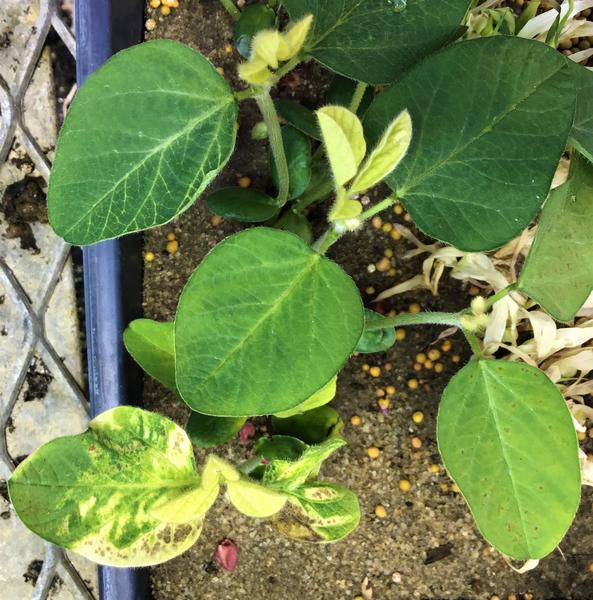Clomazone Injury
- Type
- Physiological
- Leaf Color
- Bleached
- Leaf Location
- Edge, Young
- Field Distribution
- Uniform, Random, High Areas, Edges
- Prior Environmental
- Rain, Dry, Wind
- Season
- Early Vegetative
- Cropping System
- Soybean Followed By Soybean, Conventional Till, Reduced Till
- Cotyledon Condition
- Bleaching
Symptoms
4-hydroxyphenylpyruvate dioxygenase (HPPD)-inhibiting (herbicide group [HG] 27) herbicides are commonly referred to as the ‘bleacher’ herbicides. The HPPD-inhibiting herbicides inhibit plant pigment synthesis, which results in chlorosis and/or bleaching of vegetative tissue (Figure 1). Symptomology exhibited by treated plants may range from bleaching of the leaf margins to the entirety of the leaf. The HPPD-inhibiting herbicides are phloem mobile, resulting in injury being seen on new growth.
Injury incurred by the HPPD-inhibiting herbicides on soybeans can be transient if the doses are low or can result in plant death if the doses are high. Injury to soybeans can occur from physical drift or carryover from previous growing seasons. When a soybean plant emerges with bleached or chlorotic cotyledons and true leaves, the injury is likely from HPPD-inhibiting herbicide carryover. When injury to a soybean plant is when trifoliates are bleached and the injury severity decreases across the field, the injury is likely from HPPD-inhibiting herbicide drift. Injury caused by HPPD-inhibiting herbicides can be confused with injury caused by clomazone (HG 13). Clomazone is also referred to as a ‘bleacher’ herbicide that is applied pre-emergence. Injury caused by HPPD-inhibiting herbicides and clomazone are almost indistinguishable (Figures 1 and 3). However, injury caused to soybeans by clomazone will subside with time.
Management
Carry over injury from the HPPD-inhibiting herbicides can be avoided by following the labeled application and plant back restrictions. Physical drift can be avoided by spraying when the average wind speed is less than 10 miles an hour and mid-day or –afternoon to avoid a temperature inversion.





